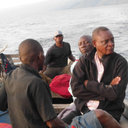About
10
Publications
5,798
Reads
How we measure 'reads'
A 'read' is counted each time someone views a publication summary (such as the title, abstract, and list of authors), clicks on a figure, or views or downloads the full-text. Learn more
195
Citations
Introduction
Skills and Expertise
Publications
Publications (10)
Declining catches of freshwater clupeids in Lake Tanganyika have recently led to widespread illegal fishing on the clupeid larvae with mosquito nets. This paper examines whether this larval fishery could have a negative impact on the exploitable biomass of the clupeid Limnothrissa miodon Boulenger and whether the sale of clupeid larvae is actually...
This policy brief (in French) is a common work of Congolese scientists and representatives of environment administrations to address the sustainability of fisheries in DR Congo. It was created and presented during a workshop organized in October 2017 by CEBioS (cebios.naturalsciences.be) in Kisangani, DR Congo.
Reproductive activities of two commercially exploited clupeid fishes (Stolothrissa tanganicae and Limnothrissa miodon) in the northern end of Lake Tanganyika (Bujumbura sub-basin) were investigated during two different years (2004-2005 and 2007-2008). We hypothesized that the timing of largest reproductive investment in these pelagic species coinci...
Catches of clupeid fish were recorded twice a week from February 2007 to May 2008 in the northern end of Lake Tanganyika, and allocated to species (Stolothrissa tanganicae and Limnothrissa miodon) according to representative catch samples from ten artisanal lift-net fishing units. In each sample, clupeids were measured and weighed for length freque...
The Nyangara wetland, also known as Laguna, in the fluvial plain of Rusizi River at the northern end of Lake Tanganyika, harbours a fish fauna which offers food and income for 500 people directly or indirectly associated with fisheries. Fishing focuses mainly on two cichlids (Oreochromis niloticus and Astatotilapia burtoni) and the marbled lungfish...
Abstract
Recently it was claimed that increase in regional temperature, related to global climate change, has resulted in substantial decline in the pelagic fish catches from Lake Tanganyika, East Africa. Surface temperatures of Tanganyika indeed show warming trends, but evidence for decreased productivity is ambiguous, and no overall decline in...
Recently it was claimed that an increase in regional temperature, related to global climate change, has resulted in substantial decline in the pelagic fish catches from Lake Tanganyika, East Africa. Surface temperatures of Tanganyika indeed show warming trends, but evidence for decreased productivity is ambiguous, and no overall decline in fish cat...
Food web structure of the pelagic community in Lake Tanganyika was studied using the stable nitrogen and carbon isotopes 15 N and 13 C. Size-fractionated seston, zooplankton, shrimps, medusae and fish were sampled in the northern part of Lake Tanganyika. Picoplankton fractions as well as cyanobacteria-dominated nano/microplankton fractions had very...
Life histories of two cJupeid fish species (Stolothrissa tanganicae and Limnothrissa miodon) in northwestern Lake Tanganyika were studied. S. tanganicae spawns offshore all the year round but more actively in the first half of the year. This fish comes to be exploited by the Zairian artisanal lift net fishery at an age of about 2 months and length...




























